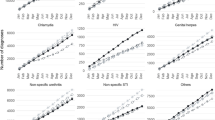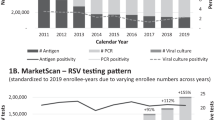Abstract
Purpose of Review
Electronic health records (EHRs) are an excellent source of data for disease symptoms, laboratory results, and medical treatments. Thus, EHR data may improve the completeness of notifiable disease case reporting and enable longitudinal collection of disease data. The purpose of this review is to examine the current state of EHR use in public health infectious disease surveillance in the USA.
Recent Findings
A wide variety of EHR data is used in infectious disease surveillance. EHR data were used to assess the incidence of Lyme disease and identify newly diagnosed HIV infections. EHR disease detection algorithms combined laboratory reports, diagnosis codes, and medication orders to identify cases and, in the case of Lyme disease, found incidence rates 4–7 times higher than those from traditional surveillance. EHR data were also used to evaluate temporal trends in sexually transmitted disease testing, positivity, and re-testing in several primary care settings. Multiple studies were also able to control for additional confounders in multivariable models, such as number of sexual partners and concurrent infections, because of the breadth of data available in EHR systems.
Summary
Studies highlighted in this review demonstrate that EHR data enhance provider-based and laboratory-based disease reports and may facilitate more complete case reporting. EHR data also provides corollary patient information that enables longitudinal disease reporting and analysis of important health outcomes. As public health infrastructure and investment allow health departments to establish closer relationships with healthcare providers, EHR data use in public health surveillance activities should continue to increase.
Similar content being viewed by others
References
Papers of particular interest, published recently, have been highlighted as: •• Of importance
Thacker S, Berkelman RL. Public health surveillance in the United States. Epidemiol Rev. 1998;10:164–90.
Centers for Disease Control and Prevention. National Notifiable Diseases Surveillance System. 2018. https://wwwn.cdc.gov/nndss/document/NNDSS-Fact-Sheet-508.pdf. Accessed on April 17, 2019.
Centers for Disease Control and Prevention. Surveillance case definitions for current and historical conditions. 2017. https://wwwn.cdc.gov/nndss/conditions/. Accessed on April 25, 2019.
Effler P, Ching-Lee M, Bogard A, Ieong M, Nekomoto T, Jernigan DB. Statewide system of electronic notifiable disease reporting from clinical laboratories: comparing automated reporting with conventional methods. JAMA. 1999;282:1845–50.
Overhage JM, Grannis S, McDonald CJ. A comparison of the completeness and timelines of automated electronic laboratory reporting and spontaneous reporting of notifiable conditions. Am J Public Health. 2008;98:344–50.
Centers for Disease Control and Prevention. CDC Public Health Surveillance Strategy Report: 2014–2018. 2018. https://www.cdc.gov/surveillance/pdfs/Surveillance-Series-Bookleth.pdf. Accessed on April 24, 2019.
Blumenthal D. Stimulating the adoption of health information technology. N Engl J Med. 2009;360:1477–9.
Marcotte L, Seidman J, Trudel K, Berwick DM, Blumenthal D, Mostashari F, et al. Achieving meaningful use of health information technology. Arch Intern Med. 2012;172:731–6.
•• Dee EC, Hsu KK, Kruskal BA, Menchaca JT, Zambarano B, Cocoros N, et al. Temporal patterns in chlamydia repeat testing in Massachusetts. Am J Prev Med. 2019;56:458–63. The EHR data in this study were from an automated feed to a public health surveillance database.
•• Dee EC, Willis SJ, Hsu KK, Elder H, Cocoros NM, Young J, et al. Gonorrhea testing patterns among males in three large clinical practices in Massachusetts, 2010–2017. Washington: Paper presented at the National STD Prevention Conference. 26–30 August 2018. Available at: https://www.esphealth.org/resources/publications-and-presentations. The EHR data in this study were from an automated feed to a public health surveillance database.. Accessed on April 05, 2019.
•• Willis SJ, Elder H, Cocoros N, Callahan M, Flagg EW, Hsu KK, et al. Impact of an electronic medical record best practice alert on expedited partner therapy for chlamydia infection and reinfection. Paper presented at the Annual CSTE Conference. Raleigh, NC. 02–05 June 2019. Abstract available at: https://cste.confex.com/cste/2019/meetingapp.cgi/Paper/11435. Accessed on June 10, 2019. The EHR data in this study were from an automated feed to a public health surveillance database.
•• Krakower DS, Gruber S, Hsu K, Menchaca JT, Maro JC, Kruskal BA, et al. Development and validation of an automated HIV prediction algorithm to identify candidates for preexposure prophylaxis. Lancet. In press. The EHR data in this study were from an automated feed to a public health surveillance database.
•• Lewis S, Morrison M, Randall LM, Roosevelt K. The Partnerships for Care Project in Massachusetts: developing partnerships and data systems to increase linkage and engagement in care for individuals living with HIV. J Acquir Immune Defic Syndr. In press. Study describes an automated feed of EHR data that is submitted for public health surveillance, along with electronic laboratory and provider reporting.
•• Reilley B, Haberling DL, Person M, Leston J, Iralu J, Haverkate R, et al. Assessing new diagnoses of HIV among American Indian/Alaska Natives served by the Indian Health Service, 2005–2014. Public Health Rep. 2018;133:163–8. The EHR data in this study were a new source of information for public health surveillance purposes.
•• Moon KA, Pollak J, Hirsch AG, Aucott JN, Nordberg C, Heaney CD, et al. Epidemiology of Lyme disease in Pennsylvania 2006–2014 using electronic health records. Ticks Tick Borne Dis. 2019;10:241–50. The EHR data in this study were a new source of information for public health surveillance purposes.
•• Kourtis AP, Hatfield K, Baggs J, Mu Y, See I, Epson E, et al. Vital signs: epidemiology and recent trends in methicillin-resistant and in methicillin-susceptible Staphylococcus aureus bloodstream infections – United States. MMWR. 2019;68:214–9. The EHR data in this study were a new source of information for public health surveillance purposes.
•• Tymejczyk O, Jamison K, Pathela P, Braunstein S, Schillinger JA, Nash D. HIV care and viral load suppression after sexual health clinic visits by out-of-care HIV-positive persons. AIDS Patient Care STDs. 2018;32:390–8. EHR data were merged with public health surveillance data to achieve the study objectives.
•• Wagaw F, Okoro CA, Kim S, Park J, Rachman F. Linking data from health surveys and electronic health records: a demonstration project in two Chicago health center clinics. Prev Chronic Dis. 2018;15:170085. https://doi.org/10.5888/pcd15.170085 EHR data were merged with public health surveillance data to achieve the study objectives.
•• Barnes SR, Wansaula Z, Herrick K, Oren E, Ernst K, Olsen SJ, et al. Mortality estimates among adult patients with severe acute respiratory infections from two sentinel hospitals in southern Arizona, United States, 2010–2014. BMC Infect Dis. 2018;18:78. https://doi.org/10.1186/s12879-018-2984-1 EHR data were merged with public health surveillance data to achieve the study objectives.
•• Kunzweiler C, Kishore N, John B, Roosevelt K, Lewis S, Klevens RM, Morrison M, Randall LM, DeMaria A. Using HIV surveillance and clinic data to optimize data to care efforts in community health centers in Massachusetts: The Massachusetts Partnerships for Care Project. J Acquir Immune Defic Syndr. In press. EHR data were used to create line lists of patients with HIV from six community health centers who were defined as out-of-care or diagnosed with HIV, but not linked to care.
Centers for Disease Control and Prevention. Automated detection and reporting of notifiable diseases using electronic medical records versus passive surveillance --- Massachusetts, June 2006--July 2007. MMWR. 2008;57:373–6.
Klompas M, McVetta J, Lazarus R, Eggleston E, Haney G, Kruskal BA, et al. Integrating clinical practice and public health surveillance using electronic medical record systems. Am J Public Health. 2012;102(Suppl 3):S325–32.
Klompas M, Cocoros NM, Menchaca JT, Erani D, Hafer E, Herrick B, et al. State and local chronic disease surveillance using electronic health record systems. Am J Public Health. 2017;107:1406–12.
Lazarus R, Klompas M, Campion FX, McNabb SJ, Hou X, Daniel J, et al. Electronic support for public health: validated case finding and reporting for notifiable diseases using electronic medical data. J Am Med Inform Assoc. 2009;16:18–24.
Vogel J, Brown JS, Land T, Platt R, Klompas M. MDPHnet: secure, distributed sharing of electronic health record data for public health surveillance, evaluation, and planning. Am J Public Health. 2014;104:2265–70.
Centers for Disease Control and Prevention. Sexually transmitted diseases treatment guidelines. 2015 MMWR Recomm Rep. 2015;64:1–137.
Centers for Disease Control and Prevention. 2017 Sexually Transmitted Disease Surveillance Report. 2018. https://www.cdc.gov/std/stats17/default.htm Accessed on April 25, 2019.
Massachusetts Department of Public Health, Bureau of Infectious Disease and Laboratory Sciences. 2016 Integrated HIV/AIDS, STD, and Viral Hepatitis Surveillance Report. 2017. http://www.mass.gov/eohhs/docs/dph/cdc/aids/std-surveillance-2016.pdf Accessed September 14, 2018.
Gaydos C, Wright C, Wood BJ, Waterfield G, Hobson S, Quinn TC. Chlamydia trachomatis reinfection rates among female adolescents seeking rescreening in school-based health centers. Sex Transm Dis. 2008;35:223–37.
Fung M, Scott KC, Kent CK, Klausner JD. Chlamydial and gonococcal reinfection among men: a systematic review of data to evaluate the need for retesting. Sex Transm Infect. 2007;83:304–9.
Hosenfeld CB, Workowski KA, Berman S, Zaidi A, Dyson J, Mosure D, et al. Repeat infection with chlamydia and gonorrhea among females: a systematic review of the literature. Sex Transm Dis. 2009;36:478–89.
Centers for Disease Control and Prevention. Expedited partner therapy in the management of sexually transmitted diseases. 2006. https://www.cdc.gov/std/treatment/EPTFinalReport2006.pdf. Accessed on September 18, 2018.
Grant RM, Lama JR, Anderson PL, McMahan V, Liu AY, Vargas L, et al. Preexposure chemoprophylaxis for HIV prevention in men who have sex with men. N Engl J Med. 2010;363:2587–99.
Baeten JM, Donnell D, Ndase P, Mugo NR, Campbell JD, Wangisi J, et al. Antiretroviral prophylaxis for HIV prevention in heterosexual men and women. N Engl J Med. 2012;367:399–410.
Thigpen MC, Kebaabetswe PM, Paxton LA, Smith DK, Rose CE, Segolodi TM, et al. Antiretroviral preexposure prophylaxis for heterosexual HIV transmission in Botswana. N Engl J Med. 2012;367:423–34.
Choopanya K, Martin M, Suntharasamai P, Sangkum U, Mock PA, Leethochawalit M, et al. Antiretroviral prophylaxis for HIV infection in injecting drug users in Bangkok, Thailand (the Bangkok Tenofovir Study): a randomised, double-blind, placebo-controlled phase 3 trial. Lancet. 2013;381:2083–90.
Smith DK, Van Handel M, Grey J. Estimates of adults with indications for HIV pre-exposure prophylaxis by jurisdiction, transmission risk group, and race/ethnicity, United States, 2015. Ann Epidemiol. 2018;28:850–7.
Chou R, Evans C, Hoverman A, Sun C, Dana T, Bougatsos C, et al. Pre-exposure prophylaxis for the prevention of HIV infection: a systematic review for the U.S. Preventive Services Task Force. Evidence synthesis no. 178. AHRQ publication no. 18–05247-EF-1. Rockville: Agency for Healthcare Research and Quality; 2018.
Cooney MA, Iademarco MF, Huang M, MacKenzie WR, Davidson AJ. The public health community platform, electronic case reporting and the digital bridge. J Public Health Manag Pract. 2018;24:185–9.
Digital Bridge Initiative: PHII Website. https://digitalbridge.us/infoex/. Accessed on April 24, 2019.
Okah E, Rogers AV, Kim M, Schillinger JA. Sentinel surveillance for expedited partner therapy prescriptions using pharmacy data, in 2 New York City neighborhoods, 2015. Sex Transm Dis. 2017;44:104–8.
Schillinger JA, Gorwitz R, Rietmeijer C, Golden MR. The expedited partner therapy continuum: a conceptual framework to guide programmatic efforts to increase partner treatment. Sex Transm Dis. 2016;43(Suppl 1):S63–75.
Author information
Authors and Affiliations
Corresponding author
Ethics declarations
Conflict of Interest
Sarah J. Willis, Noelle M. Cocoros, Liisa M. Randall, Aileen M. Ochoa, Gillian Haney, Katherine K. Hsu, Alfred DeMaria, Jr., and Michael Klompas declare that they have no conflicts of interest.
Human and Animal Rights and Informed Consent
This article does not contain any studies with human or animal subjects performed by any of the authors.
Additional information
Publisher’s Note
Springer Nature remains neutral with regard to jurisdictional claims in published maps and institutional affiliations.
This article is part of the Topical Collection on Technology and Infectious Disease
Rights and permissions
About this article
Cite this article
Willis, S.J., Cocoros, N.M., Randall, L.M. et al. Electronic Health Record Use in Public Health Infectious Disease Surveillance, USA, 2018–2019. Curr Infect Dis Rep 21, 32 (2019). https://doi.org/10.1007/s11908-019-0694-5
Published:
DOI: https://doi.org/10.1007/s11908-019-0694-5




